Introduction
As part of WeMake - OpenCare - Maker in Residence Program we met together with Silvia and Chiara from the OpenCare team to explore the main steps of the Agile Planning regarding WeHandU.
The WeHandU project started in 2016 with Alexander to explore if We can Hand You our knowledge about technologically based solutions for improving autonomy in daily living. As a crowd based solution different people are encouraged to join in at different times; thus the challenge is to embrace chaos and define what direction the project can take. It’s a cloud of concept of occasional contributions aiming towards development of a platform for bringing emerging rehabilitation technology or ideas into practical use.
01_Why are we here
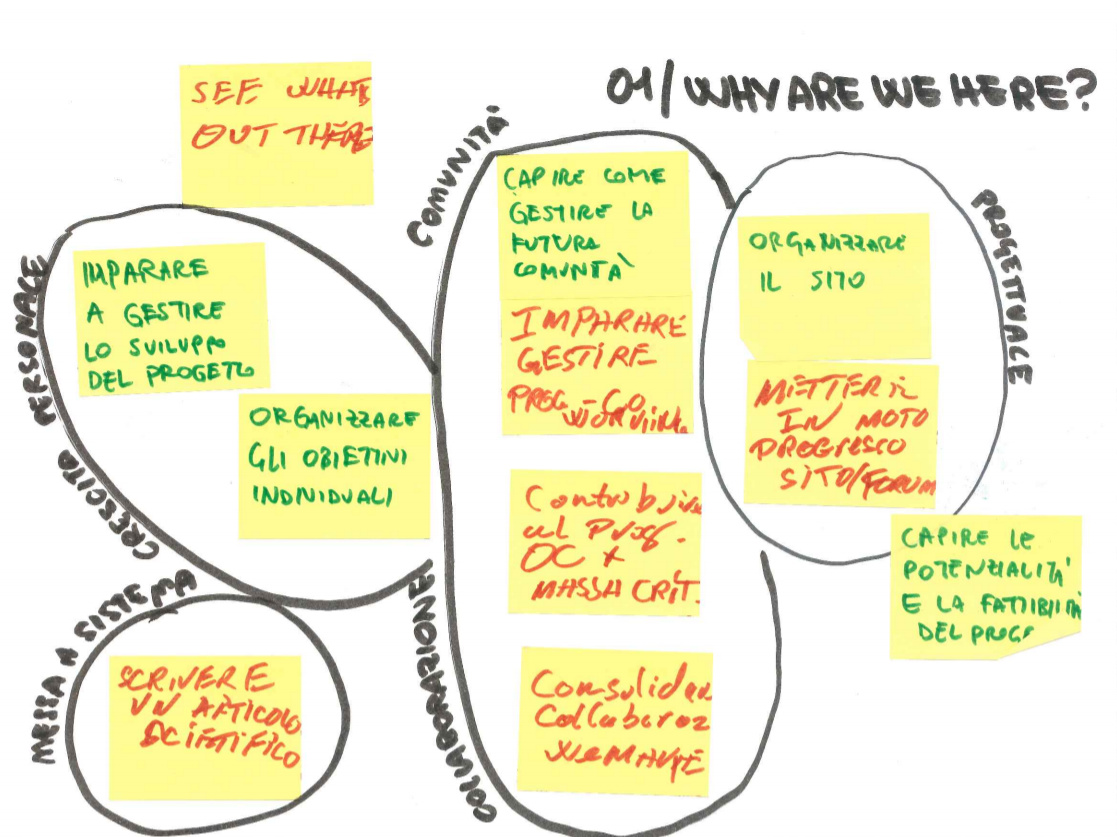
To get a better understanding about what brings us together in this project, we sat down and wrote posters mentioning the main objectives of the project that were divided later into groups. The result was four groups as seen on the foto above. Chiara was helping us by synthesizing some headlines written in black.
Crescita personale - Personal growth
The aim is to learn how to manage a distributed community, dividing the objectives and tasks for each person involved. The main outcome is to create a platform thanks to which people will find, create and share personalized assistive devices. Consequent but fundamental outcome of the project is the creation of growing awareness among the society regarding modern accessible technology that brings people freedom to create customised assistive/rehabilitative solutions without initial specific knowledge and preparation, becoming more independent physically.
As this project has a novel approach and objective with no known preceding experiences to draw from it is also an opportunity for personal development of the involved people.
Messa a sistema - Documentation
Being research relying heavily on academic resources, we are interested in understanding how this research can be of scientific value. An objective is to write a scientific article in synergy with the open-source/sharing philosophy of the project. The subject matter of such publication will be to demonstrate and prove the viability of the approach, answering the question: can the creativity of people with physical limitations be leveraged to help them solving their personal needs?
Collaborazione & Comunità - Collaboration & Community
WeHandU activists need to understand and learn how to manage the community. Co-working, open-source and collaborative design and production without top-down control requires understanding of the social mechanisms that motivates people to contribute actively. How can we reach a critical mass to consolidate continuous collaboration network (People with needs –> makerspace <– Research and Healthcare providers)?.
Progettuale - Project content
As part of collaboration and management the WeHandU.it is a site under construction. It could become a hub serving different functions; informations about solutions and possibilities, a place where people can meet, discuss and share ideas and offer the possibility to share content and join discussions forums.
Capire le potenzialità - Assessing feasibility of the idea
The endpoint of the project should be to draw conclusions and directions for further development of the feasibility of the proposed approach.
02_Brainstorming
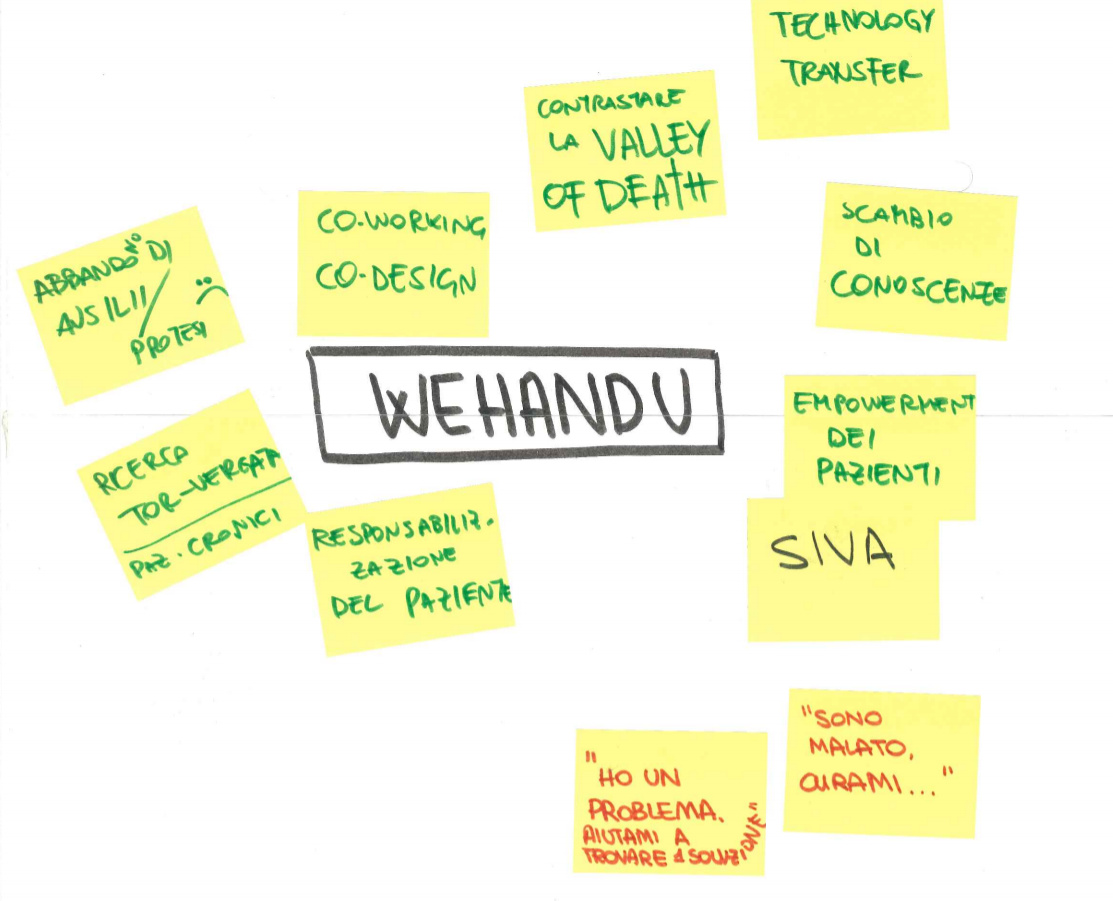
Then we had a brainstorm session. Here, anything that comes into your mind is possible and serves to analyze the common factors. We came up with 10 discussion points:
Technology abandonment (literature tells us that a large proportion of existing assistive devices are abandoned. Mostly because they don’t meet the user’s expectations and needs)
Co-Working/Design (involvement of all stakeholders in the realization)
The valley of death - known to be the problem of letting a conceptual idea become available to the user. Many ideas ‘die’ while trying to become a commercial product.
Knowledge exchange - on one hand we have knowledge of what can be done to help people, on the other hand we have people who have knowledge of what help they need.
Empowerment is a recent ‘buzzword’ in rehabilitation, meaning people taking responsibility for their care.
SIVA.IT is an example of an empowering service (evaluation and consultation on choice of assistive technology. A leader among seven major national portals throughout Europe. )
“I’m disabled, help me” the classical paradigm of care. This leads to next point:
“Help me find a solution” which is the foundation of the WeHandU paradigm to explore.
“Responsibility of the patient” … to become a creator of solutions.
“Research evidence” shows that increasingly more chronic patients are inventing solutions for alleviating their problems on their own.
Our hypothesis is that, there are resources out there that hasn’t been used yet, creativity(or critical opinion/evaluation) of the user, of those who look for a personalised solution(assistive technology). New technologies like 3d printing enables us to create personalised solutions.
03_Create an elevator pitch
So how do we explain all this in a few words?

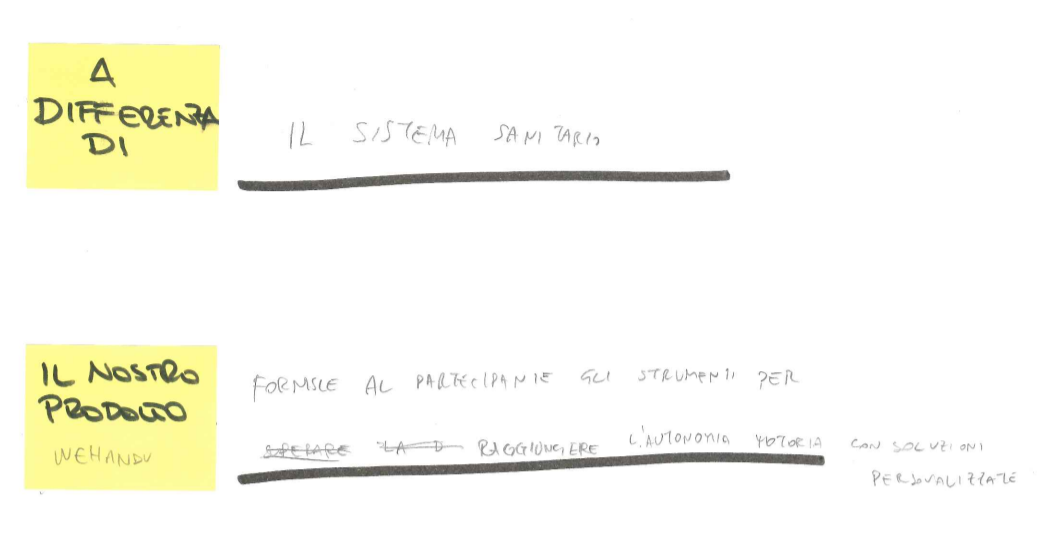
The project WeHandU is an open system/service/experiment that assists in generating ideas, project-design-make and share the solution for/with people (having/not having special needs to help coping with physical limitation/disability) that seeks to produce useful devices that facilitates physical activities of daily living in contrast to the classical healthcare model.
04_Meet your neighbours
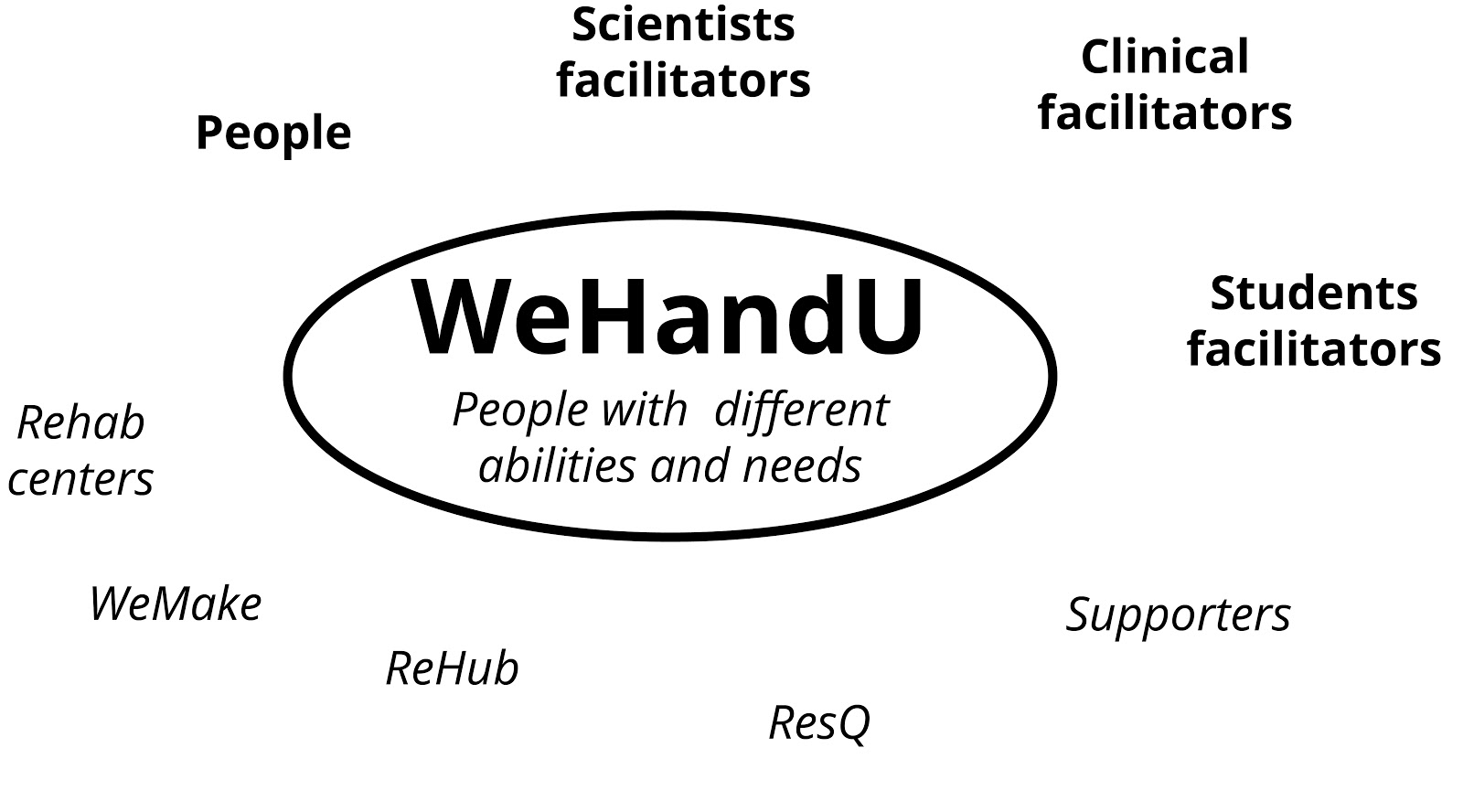
WeMake: The OpenCare can be thought of as a container class containing a variety of projects of which WeHandU is a specifically focused embodiment
ReHub: Is working on a rehabilitation glove. Can we collaborate on in clinical trials
ResQ: Is working with software. Could it develop as a recruitment/collaboration app.
And fortunately Silvia gave us a hand here on the graphical side:
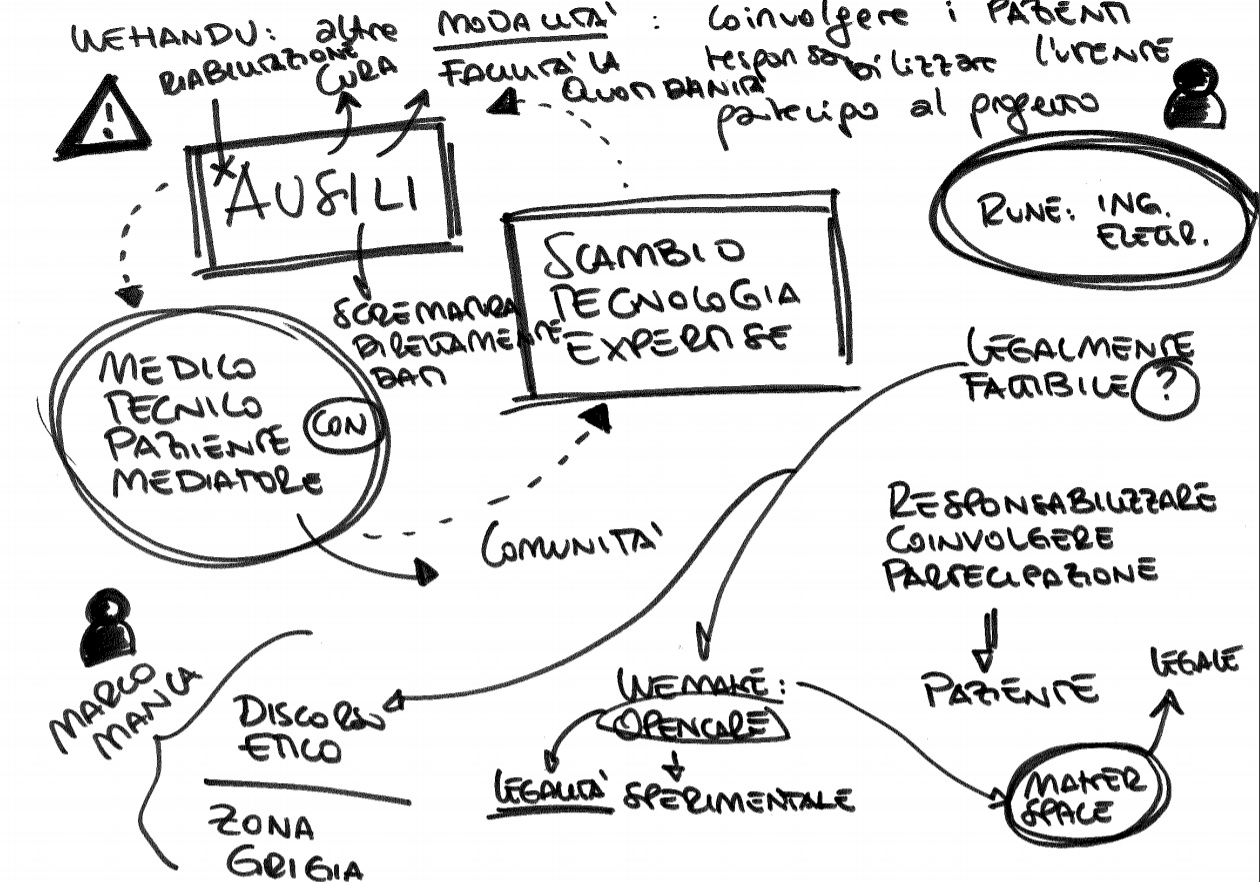
It connects all the arguments that we touched during the Agile planning phase.
Conclusions
WeHandU is a prototype framework: Overall objective is to test if people who are motivated to solve their personal needs, can be empowered to create an assistive device for themselves. We will support them in the process using this rapid prototyping technology.
So we can summarize this to the following structure with a trinity of roles:
Participants: Promoters of awareness of the needs. They are protagonist of a path to autonomy conducted by “carriers of interest”
Mentors: Expert participants helping to understand the possibilities. Linking new with existing solutions and making the whole process sustainable and scalable.
Facilitators: Assisting with preparation, analysis, study and realization of individual solutions. Keeping scientific approach to problem solving, promoting reproducibility.
A long learning process on Agile planning in a chaotic crowd is ahead before the action can start. Action must start to create content. We need to select and implement adequate technology and tools, workflows, meeting cultures and know our collaborators. Since the project aims to create a platform with an active and independent community, it is important to find the tools to manage an open source coworking/codesign project, and to learn how to reach the critical mass to consolidate the collaboration with WeMake. Meeting may happen both in person and through video-call, thus keeping contact with everyone, even if mobility issues keeps them distant from the operative core.
The work that has been done at WeMake, had showed us more in detail the importance of the team work and precisely planned tasks and gave as more tools to organise the work - e.g. Github
This project is very ambitious, that’s why it is crucial to create step by step phases that will proof project efficiency on the early stages and/or discover more objectives that are vital for the success
We found that team is aligned on the main objectives
We have realized the importance of interaction with more organisation (e.g.makerspaces, other healthcare initiatives) that will help us to build and test our service
Next steps
- To complete a concrete prototyping project for the WeHandU framework.
- Identify a person who becomes a Participant in the WeHandU…
- …Who has a concrete solvable problem and is motivated.
- Letting the Facilitators device and propose a initial solution which the Participant can realize.
- Through engagement in the affine processes encourage the Participant to become Mentor for future events
- Harvest data from this prototyping experience
- for publication
- consolidating/developing/correcting workflow
- list and publish lessons learned
Disclaimer: The purpose of this article is to stimulate discussion. The information and opinions expressed herein is for general information purpose only and is provided by several authors in their personal capacities and do not reflect the opinion of their employers, affiliates or other third parties. Neither shall the authors be held responsible for the correctness of the information and materials provided here.